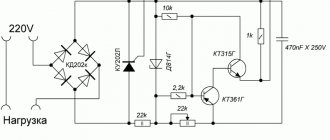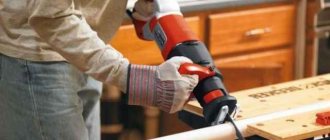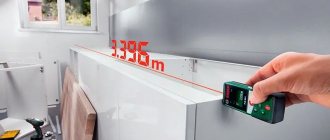A plumb line is used to determine the evenness or presence of deviations in a vertical plane (wall, cabinet, picture, etc.).
When carrying out any construction activities, it is important to clearly carry out all measurements, the correct location of the various elements and their relationship to each other.
And to ensure that all measurements are carried out correctly, there are many special devices that greatly simplify such manipulations.
One of these tools is a plumb line.
Scope of application of the construction plumb line
Despite the simplicity of the tool (you can make it with your own hands from a rope and a weight), it will become absolutely necessary when carrying out construction and finishing work. It is also used for high-precision excavation work.
The plumb line will provide invaluable assistance with:
- Installation of beacons during wall alignment;
- Wallpapering;
- Control of surface evenness;
- Drawing vertical lines;
- Installation of doorways and window frames;
- Installation of roof and formwork;
- Checking the evenness of ditches, ditches and other holes.
You can even use it for such non-construction purposes as hanging pictures and photographs or installing cabinets.
The principle of operation of the device is extremely simple and does not require fundamental knowledge in the field of physics: a load placed on a freely hanging rope will create a perfectly straight vertical line.
Device and characteristics
The design of a conventional plumb line consists of a weight, which has the shape of a cylinder with a pointed end (visually the object resembles an oblong bullet) and a cord attached to the center of the base of the weight.
Using this device, you can quickly check the verticality of various surfaces or buildings, and, if necessary, mark vertical lines on a wall or other covering.
The price of plumb lines is more than acceptable.
You can buy such a product for an average of 100 rubles.
But it is worth considering that more modern models equipped with additional functions will differ significantly from the declared cost.
Manufacturing materials
In most cases, aluminum sheets with a thickness of no more than 2 millimeters serve as the bar. It is convenient to wind the thread on them after use, and the material is lightweight and durable.
- Nylon or nylon threads are used as a cord. They are not affected by water or cold, glide well and do not get tangled.
- The weights are steel blanks in the shape of a cone. This shape allows for maximum balancing and minimal sway.
- Steel is considered the most suitable option: it has high hardness, durability, and optimal weight, allowing it to react less to gusts of wind.
The disadvantage of the material will be its high density: if it falls, the plumb line can damage the finishing materials laid underneath it.
To prevent such troubles, weights made of dense rubber are used. The material is a bit like hockey pucks and is elastic, heavy and rigid. Such a load, even during a fall, will not cause harm to the lying materials.
Algorithm for working with marking cord
The design of the device is quite simple, using the marking cord is also easy.
How to refill
In order for the cord to leave a clear and contrasting mark on the marked surface, the body must be filled with high-quality coloring powder. During the unwinding process, the thread is coated with powder and becomes ready for marking.
In order to fill the body with dye, you need to unscrew the cap covering the loading hole. Powder is poured into it.
Its supply inside the case will have to be replenished whenever the marking line, broken off by the cord, begins to fade.
When using for the first time after purchase, you must completely unwind the thread and fill in the pigment to three-quarters of the volume of the body. Next, the thread is wound up and the device is shaken vigorously. You should not save on purchasing a coloring composition. In Moscow, powder of acceptable quality should not cost less than 80-100 rubles
How to thread the marking cord
Performing markup
First, using a hydraulic or laser level, reference points are placed at the beginning and end of the marked line. Screws are screwed into them or small nails are driven into them. The marking thread is stretched between them. Now you need to take the cord by the middle with two fingers, pull it a little in a direction perpendicular to the surface and the marked line and release it. A clear straight line should appear on the surface. Now you can remove the cord from the markers and move on to marking the next line.
If it is possible to attract an assistant, the work will speed up significantly. No need to attach markers. One presses the beginning of the thread, the other the end. One of the workers pulls back and releases the thread.
Marking with marker cord
How to use a marking cord correctly in specific situations?
To mark gypsum suspended ceilings, you must follow the following recommendations:
- Find the lowest point on the rough ceiling, which will be covered with plasterboard. To do this, use a hydraulic level or level. It will be much more convenient and faster to use a laser level. Its high price will pay for itself many times over due to the time saved.
- At the found level, a mark is made on the nearest wall. Using a level, spirit level or laser level, I repeat the mark twice on each wall.
- The beginning and end of the marking cord are recorded using the marks set; it should fit snugly to the surface.
- Take the thread by the middle with two fingers, pull it a little and quickly release it. After impact, the paint powder leaves a smooth mark on the wall.
- The operation is repeated on the remaining walls.
The broken contour will serve as a guide for installing the starting guide profile, to which the suspended ceiling will be attached.
If the room has an imperfect shape, deviating from a regular rectangle, then when laying ceramic tiles on the floor, even rows will emphasize this. In one corner the wedge will be clearly visible. To disguise such a defect, the tiles are laid diagonally.
Marking with marker cord
To apply diagonal markings to the screed under a ceramic tile floor, proceed as follows:
- The marking cord is pulled between the corners of the room at a height of 5-10 mm from the surface of the subfloor and the main diagonal is marked.
- The cord is stretched between the other two corners and the second diagonal is beaten off.
- The intersection point of the two lines will mark the geometric center of the room;
- From it, on both sides along the main diagonal, the first two rows of tiles should be laid out, using centering crosses to maintain equal distance and spacing.
Next, the rows of tiles are laid from the center to the auxiliary corners, using the first two rows as reference ones.
Plumb weight
Depending on the purpose of using the plumb line, weights of different weights are used:
- for indoor work, a mass of 100 grams is sufficient;
- on the street you will need a slightly larger load, within 300 grams;
- in strong gusts of wind, even heavier heads are used.
However, tools with such weights are more expensive and less convenient to carry and use. And there will be more damage when such massive weights fall.
How to use?
What is a plumb line with a cord and how to use it, we will consider further.
Using this device, check the verticality of walls and other surfaces. Measurements are carried out as follows:
- The instrument is fixed at the highest point of the object under study. Some modifications are equipped with a special washer fixed on the reverse end of the cord.
- Place the washer on the plane and wait until the weight stops oscillating.
- The difference between the surface being tested and the thread stretched vertically is then measured.
In some modifications, the lace is disguised in a plastic case (like a tape measure). This part can be used as a thread support. During certain construction work, there is a need to keep the specified tool in constant proximity. To do this, use elementary fasteners: a nail, a screw, a self-tapping screw.
Having a template constantly in front of your eyes, the evenness of the surface is monitored when plastering or similar work.
Plumb line length
The standard version provides a length of 5 meters. But for interior spaces, a height of 2.5-3 meters is quite sufficient. This is quite enough to decorate any living space.
Peculiarities
Along with the construction bubble level, the plumb line is one of the devices without which almost all basic construction work cannot be done. List of some operations:
- checking the straightness and verticality of the walls;
- control of the correct assembly of furniture and household appliances;
- checking the evenness of the brickwork.
A weight suspended on a thread is applied in turn from both sides, checking the distance to the cord along its entire length. It should be identical everywhere. Distance control is performed at several different points. The verticality of surfaces constructed from logs or timber is checked using the same principle. If non-cylindrical elements are used, it is necessary to take into account the difference between the sizes of the crowns.
Despite all the practicality and simplicity of the device, it has a significant drawback. Since construction operations are often carried out outdoors, gusts of wind do not allow fixing the device. The problem can be solved very simply by first lowering the load into a container of water. A slight wind in this case will not be a particular hindrance.
Types of plumb lines
Gone are the days when builders made plumb lines from scrap materials or secretly made them in factories.
Today's engineers have tried to diversify even such a simple tool.
So in stores you can find similar devices of a wide variety of types.
- Classic (cord) plumb lines. Such tools have remained virtually unchanged since their inception. The only additions were a built-in magnet for attaching to an iron surface, a needle for attaching to wood, and a hole on the bar for attaching to a nail. But these possibilities are not realized in every plumb line.
- Reel plumbs. For ease of use, the bar can be represented by a spool into which the thread is wound. The device slightly resembles a tape measure or a spinning rod box, is small in size, and allows you to avoid wasting time untangling the thread of a conventional device.
- Laser plumb lines. They are considered a more advanced technique, adapted for carrying out grandiose work. The device does not take up much space and can be powered by batteries or a rechargeable battery, depending on the model. All data is displayed on the screen. Additional functions include determining errors not only on vertical, but also horizontal surfaces, as well as angles.
- Electronic plumb lines. In fact, this is just another mobile application. It is supported by the Android operating system and is becoming more and more popular every day. After all, you can use it at any time without additional devices.
A separate category is made up of homemade plumb lines, consisting of twine (clothesline, nylon cord, woolen or ordinary thread) and a bolt (washers, screws, water bottles, other devices at hand). All this can be easily assembled on site and can also be easily disassembled into individual parts.
Overview of components
To assemble a reliable, stable and strong structure, the master must have a certain supply of components from which the scaffolding will subsequently be made. Let's take a closer look at exactly what elements will be needed to carry out such work.
- Sturdy vertical posts. They will bear the brunt of the load. They are placed on a pre-prepared site, after which all other necessary structural elements are attached to them.
- Spacers that can be placed diagonally or horizontally. These elements subsequently serve as connecting nodes for the racks. With their help, the entire structure becomes stronger and more stable.
- The lintels on which the plank flooring will be placed in the structure. Typically, their width ranges from 1 to 3 m. The height of the tier primarily depends on the exact location in which all installation work is carried out. Basically, this parameter is 1.8-2 m.
- Stops are very important details of the future design. They are necessary so that the structure can stand level and securely on the prepared ground.
- Stairs on which craftsmen can safely and easily climb up or down from scaffolding.
- The necessary fasteners with which all elements of the structure will be connected to each other. Often, to assemble the products in question, a special fastening component is used - a ring screw or a welded hook.
- If the structure is planned to be adjustable, screw supports are used.
Mesh fabric also effectively protects from the aggressive effects of sunlight, rain, and snow. It is much more comfortable and easier to work with such an element than without it. A significant drawback of the mesh is that it certainly begins to accumulate and trap dust. When grinding the surface of the façade or when working with toxic components, it is better to remove the mesh and use respirators for additional protection.
Criteria for choosing a plumb line
When choosing a plumb line, pay attention to:
- Type of construction work required;
- Material of manufacture;
- Thread length:
- Required measurement accuracy;
- Additional features.
The cost of the device may vary from manufacturer to manufacturer. But to a greater extent the price depends on the number of additional services, which are not always used. So for small DIY repairs, it’s quite possible to buy the simplest model.
Laser modifications
The vertical position of the surface under study can be checked with laser plummets. The simplest representative of this category is the pointer. It is made like a keychain with a laser target pointer. There are not so many similar devices focused exclusively on construction work. One of the modifications is a metal body, on the pin of which the pointer is located.
You may be interested in: How to make homemade woodworking machines with your own hands: milling and lathe
The device generates points on the floor and ceiling. The leveling process occurs automatically using a special mechanism that vaguely resembles an analogue of a cord plumb line. Well-known manufacturers in the construction market offer devices with an operating range of up to 30 meters. They are highly accurate, powered by batteries, and quite expensive.
Inexpensive products from little-known companies and homemade versions are widely offered in the markets. Such an instrument requires control testing using reliable reference instruments. One of the design options is a plastic case with an LED placed inside and a self-leveling system that responds to a certain degree of deviation in the horizontal plane.
Some tips
Classic plumb lines do not require much knowledge. It is enough to fix the bar on a vertical surface, lower the cord and wait for it to fix in one position.
Laser and electric plumb lines have instructions that you should read before starting work.
In strong winds, stabilizing liquid will help to obtain readings of a classic plumb line. To do this, you will need a container with a fairly viscous liquid (shampoo, liquid soap, dishwashing detergent will do).
The container is placed along the line of the thread so that the load does not touch the walls. Stabilization of the plumb line in this case occurs much faster, and the readings are more accurate.
Basic Rules
There are no special recommendations when working with a plumb line.
The only thing that must be taken into account is a distance of 2 - 3 cm from the surface being measured.
Under no circumstances should planes be measured close to a vertical plane, as the test results will be distorted.
If irregularities are identified, for example, when laying brick walls or installing doors, then you need to compare the distance from the object to the device not at one point, but along the entire length.
If you use a laser or electric plumb line, then measurements should be taken exactly according to the instructions.
Photos of construction plumbs
Electronic version
This is not a plumb-line device, but an application installed on an iPhone or Android. One of these programs has the original name “Armed Carpenter”. This version is not considered a professional tool, but it allows you to evaluate the degree of evenness of a particular surface, determine the quality of the finish, and the correct installation of furniture or home appliances.
The operating principle of such a device:
- the application is launched and applied to the object under study;
- a coordinate system with a depicted weight will appear on the display;
- the deviation is visible visually, additionally the results are displayed at the top of the screen;
- the error relative to the conventional system (in degrees) is also displayed.
A similar application is available for smartphones and tablets, it is called Plumb-bob. The program makes it possible to measure distance, angles, horizontal and vertical lines. All measurement results are calculated based on photos and loaded parameters that you need to strive for.
Water (liquid) level
Another name for this tool is a hydraulic level. It is a rubber thin transparent tube. It works on the principle of communicating vessels, that is, the water level at the ends of the hose will be the same. Of course, if the device is not twisted.
Sometimes there are flasks at the ends of the hose, but they only harm the work, as they interfere with accuracy. Professionals most often either remove them or immediately buy the option without flasks. This tool is used only for horizontal measurements. Most often, at the very beginning of the renovation, they use the “horizon”, along which there is a guideline for floors or ceilings.
Terms of use
First you need to fill the hose with water, not reaching the ends by about 10–15 centimeters. Further work is done with a partner. One person stands at the corner and places a point at the desired height, then brings the water level in the hose under this point, raising and lowering the device.
At this moment, your partner stands in another corner and places the hose at approximately the same level. The first person at this moment watches when the water “settles down” and stands exactly at the mark. When this happens, the partner must make a mark in his corner, then move on to the next one. Next, the marks are connected with a paint cord or a pencil with a tape measure.
An example of work can be seen in the video.
Peculiarities
Since the length of the hose sometimes reaches 10 meters, work is only possible with a partner. But this makes it possible to “draw the horizon” even on a large construction site.
The hose requires careful storage without twisting or rough bends. Not suitable for work in winter in unheated rooms, since water can change its density.











